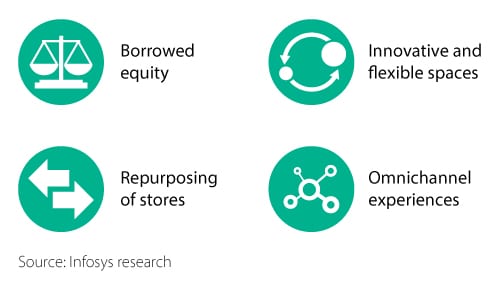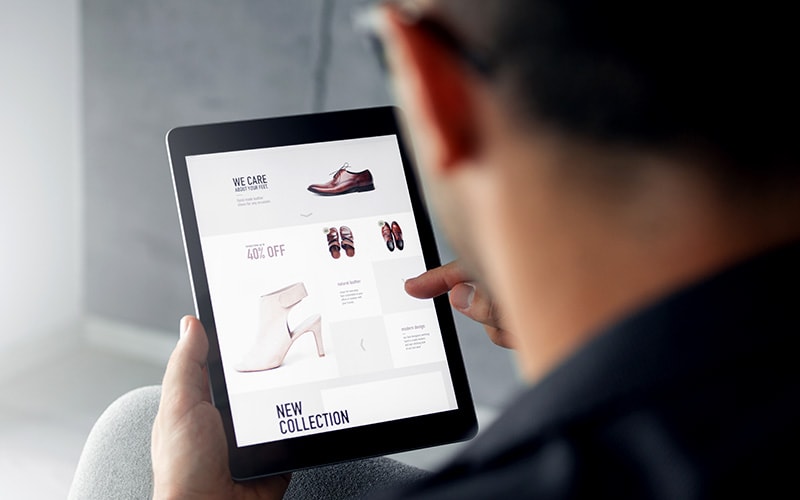It’s no secret that the U.S. is “over stored,” with two times more square footage of retail space per capita than anywhere else in the world.1 Retailers with prime real estate positions are facing hard questions in an era when store and mall closures are an everyday occurrence.
Brands with otherwise successful product lines are also in danger because of commitments they made for their physical stores. Jamie Salter, CEO of Authentic Brands Group, who runs stores like Aeropostale, Juicy Couture and Nine West, recently said “they have a rent problem” when talking about distressed brands. He recalled a story where he spoke with one of his major mall partners, General Growth Partners and they asked him to “please stop closing stores.” He asked them to attract more buyers and/or lower the rent, but they said they could not. His response was “then I can’t stop closing stores.” Given the headlines of the past few years and predictions around the “death of the mall,” this exchange isn’t too surprising even when talking about strong, legacy brands.2
Additional pressure has fallen onto anchor stores with the highest square footage, which have drawn traffic that helped malls’ other stores. The death of traditional anchors like Sears reveals that sometimes this pressure is insurmountable. The stores that remain when an anchor leaves, along with the malls themselves, will have to change or close.
For brands and retailers, the real questions are where, what size and how to bring their offering to market in such a volatile environment.
Complicating the conversation further, and not as well reported, some malls are doing well — proving they have a future. Strong-performing malls continue to see year-over-year growth, as do their tenants. There has also been success from data fueled direct-to-consumer brands that are selectively opening stores to great traffic over the past year. While shopping traffic numbers have stayed stagnant at those malls and stores, shoppers are actually spending more per person and per visit than before. The shoppers present are ready to buy.
The problem facing retailers today is multifaceted, and one solution isn’t going to help everyone. But stores are starting to aggressively change, adapt and innovate in hope of repurposing and reinvigorating their real estate, converting it from a liability to an asset.
It is also helpful that sales per square foot, which used to be the primary metric of success, has been strengthened by a number of creative attribution models. These models take into account the new ways that shoppers are discovering, buying and fulfilling orders from stores. Paula Price, Macy’s new CFO, pointed to this new type of success measurement and the reality that not every tactic has a direct way to measure ROI. Much of their recent success has come from an attitude that says “if it just makes sense for the customer, we are going to do it.” Macy’s also measures success by customer instead of store, as they have realized their best shoppers “shop at least two different stores and online.”3
As retailers and brands rethink their market strategies, a new approach is needed to deeply understand the evolving consumer and how to meet their changing expectations. This requires creation of human centric experiences powered by technology and focused on four major trends driving retail into the future:
Figure 1: Four major trends driving retail

Borrowed equity
Retailers are focusing on shopper insights to guide them in thinking of new ways to utilize their real estate. For instance, 69% of shoppers expect to see new merchandise when visiting a store and will come back more often if they feel it will happen.4 At the same time, direct-to-consumer brands are realizing that e-commerce penetration by category is limiting to the type of growth they desire. While they build up deep reservoirs of data and huge followings online, they are looking for retail outlets of their own. This convergence sets up the notion of borrowed equity very nicely.
Target is pushing the notion of borrowed equity and has gone as far as investing $70 million in Casper to back up its belief. In addition, a spokesperson said that the company is “aggressively” seeking new digital brands to bring into stores in every category. Aside from Casper, the company now sells formerly online only brands including Harry’s, BarkBox, Quip and Native.5
Macy’s has taken an aggressive push, investing in b8ta and giving prime real estate in some of its stores to the innovative retailer that helps bring small, startup and digital only brands to physical retail. The large retailer recently made Rachel Shechtman its chief experience officer after the purchase and assimilation of her popular Story store concept. These Story installations read like a magazine where all the merchandising of products is centered on a specific theme. The richly experiential spaces are helping redefine the image of Macy’s, according to Chief Digital Officer Naveen Krishna.
Borrowed equity also helped Ulta grow 14.1% last year on the backs of digitally native brands like Kylie and Morphe with their huge social followings.6 Showfields in New York City is a store completely dedicated to leveraging the audiences of its four floors of digitally native vertical brands, while Neiman Marcus allocated an entire floor in its new Hudson Yards flagship as flexible space for the very same thing. Even drug and specialty retailers are getting in on the act, like Birchbox and Walgreens, or Banana Republic and Cos Bar.
Borrowed equity is a solution to multiple problems, as it delivers on new customer expectations while allowing retailers to utilize existing assets in new ways.
This trend will redefine existing retailers for years to come and is part of a larger repurposing aimed at addressing the real estate problem head-on.
Repurposing of stores
As changing consumer expectations have driven people toward Amazon, with 73% saying it is where they go when they are ready to buy, stores of all types have had to repurpose their real estate.7 Repurposing of stores has made huge, successful strides over the past few years and has helped create competitive advantage for those doing it right.
The notion of changing your store into a fulfillment center is one of the shifts powering this trend.
Best Buy started fulfilling online orders from local stores to turn their business around in the age of Amazon. Target is a recent beneficiary of this strategy. They recently reported that 75% of their online sales are now ful filled by local stores. Utilizing traditional retail properties in this way also plays right into buy online, pick up in-store (BOPIS) and curbside, which are gaining popularity with shoppers.
Dick’s Sporting Goods has also shifted the use of its real estate to boost business. As their online sales have grown to nearly 23%, they are still looking to open new stores, and malls are pretty happy about it. Their status, primarily as anchor tenants, means they have entrances to the outside that allow for things like BOPIS and curbside pick-up, and large storage space to house inventory for both the store and online orders.8
With the growing influence and percentage of online orders and BOPIS, returns are also on the rise. Aside from fueling a rapidly growing marketplace of third-party vendors willing to help with returns, it has made retailers rethink their spaces in response. Amazon is no stranger to returns and made a really smart move in partnering with Kohl’s and its retail footprint as return drop-off locations. It’s a smart move by Kohl’s as well, generating a new traffic source to its real estate. Amazon-owned retail locations, specifically Whole Foods, will start to roll out return servicing as well. Finally, Nordstrom’s Men’s Store in New York City is testing kiosks in the store for self-service returns.
Retailers are getting smart with their real estate and repurposing it to turn a liability into competitive advantage. However, not all retailers are going to be able to survive this way. With high rents and long commitments, malls also need to start acting creatively to change the conversation.
Our clients like Ulta have revamped consumer interaction experiences online to better match with and connect online and offline experiences. Ulta.com grew revenues 53% by reimagining the online experience and creating a new e-commerce platform. The experience overhaul also drove 750,000 downloads of their mobile app, guaranteeing more customer engagement opportunities.
Innovative and flexible spaces
When it comes to retailers like Authentic Brands Group, their stores need and want malls to do better, but they are in more of a unique situation as an “interior” store. Their ability to flex their space and create the types of experiences that consumers now expect will require a number of shifts in format, structure and digital integration.
An interesting company called Convene has purchased an anchor store in New York City’s high-profile Brookfield Place and will have 73,000 square feet, with plans to convert it into a venue for conferences, corporate meetings and cultural gatherings. That means a quarter of the 300,000-square-foot mall will pivot away from retail when the new event venue debuts in November 2019.9
This notion of creating more diversity of usage in malls, to complement retail, is at the heart of new strategies by companies like WeWork, which has developed its Made by We concept in New York City. This complementary approach combines coworking space with innovative retail spaces and concepts that aren’t tied to traditional rent structures and sales per square foot metric. Billed as a “town square” for mission-driven projects and small businesses, Made by We will be another consideration for brands and retailers to consider in the expanding universe of innovative and flexible tenant spaces.10
Pop-ups are a continuing trend, made legitimate by retailers like Nordstrom and J.Crew, which lend themselves to flexible, short-term leases. Malls are now looking at dedicating space to pop-ups and adjusting normal structures to accommodate them. Pop ups are great for retailers and brands to test concepts, merchandising and even product development, which will help retail as a whole. Amazon recently closed 87 of its pop-up stores, but only after gaining a tremendous amount of data that helped it to focus on its next generation of physical retail, including the 4-star and Bookstore concepts.11
Finally, malls and retailers alike are helping drive participation, traffic and engagement for their retail partners through innovative digital, omnichannel experiences.
Omnichannel experiences
Shoppers lose trust in retailers when they have different experiences across different channels. They return to those providing consistent experiences — a reality since e-commerce entered the scene. However, new shopper expectations transcend this continuity alone and desire the connection of the multiple channels where they discover, try and transact. The technological hurdle at the heart of connecting experiences is inventory transparency. This real-time exposure of inventory across channels allows for BOPIS and the use of stores for e-commerce fulfillment mentioned earlier. It also powers numerous “endless aisle” executions in stores.
Connecting accounts and prior purchases is also of great use to consumers and retail operators alike but presents numerous technology hurdles. This is especially true when empowering retail associates with information to better help them provide needed context in the moment and to fuel personalization outside of a retailer’s website or app.
Walgreens is an example of what happens when all of these systems come together. Since they offer prescriptions, there is even more need for integration and two-way communications. Utilizing Walgreens’ online and mobile tool set, shoppers see inventory, create BOPIS requests, and order and fulfill prescriptions while being directed to the nearest store. In the store, associates are now connected with devices to better help them navigate more than 100,000 SKUs with shoppers and allow them to see past-purchase history and current order status.
Another retailer setting the gold standard for omnichannel is Starbucks, who was able to eclipse 11% of purchases via mobile-order pay, and increase participation in its loyalty program, gathering data to better service consumers across the ecosystem. To cap it all off, 1 in 3 transactions happens via mobile payment, setting the standard for retail of all types.12
Adidas, an Infosys and WONGDOODY client, is a leader in creating omnichannel experiences powered by technology. By building a Salesforce Commerce Cloud deployment, we were able to create more inventory transparency by connecting online and offline globally. This created 200% year-over-year growth on key shopping days while setting the stage to increase loyalty via in-store and online experiences.
We have created similar functionality for retailers like Hudson’s Bay, driving a more than 20% increase in store orders, and consumer brands like Beats by Dre and Starbucks, powering their omnichannel feedback survey.
Getting started
In today’s retail environment, a couple of things are becoming clear. First, there is no one-size-fits-all solution to meet changing customer demand. Second, and perhaps more significant, technology transformation is important, but it is only part of the equation.
Retailers and brands will succeed in the future by enabling experiences powered by refreshed technology and using them to connect and fulfill human expectations.
References
- PSFK - Brief on Store Experience - March 2019
- Digiday - How Target is getting more DTC brands to sell in its stores - March 2019
- WWD - Kylie, Morphe and Other Digital Brands Drive Ulta Beauty Foot Traffic - March 2019
- PSFK - Brief on Store Experience - March 2019
- Digiday - How Target is getting more DTC brands to sell in its stores - March 2019
- WWD - Kylie, Morphe and Other Digital Brands Drive Ulta Beauty Foot Traffic - March 2019
- Marketing Dive - 73% of online shoppers click on Amazon product ads while browsing, study finds - March 2019
- The Motley Fool - How Far Is Dick’s Sporting Goods From Its Goals? - March 2019
- Bloomberg - NYC’s Brookfield Place Mall Gets New Top Tenant After Saks Exit - March 2019
- Curbed - WeWork opens combination cafe, retail, coworking space in NYC - January 2019
- Forbes - Amazon Is Closing 87 Pop-Up Shops but Has Other Brick-and-Mortar Plans - March 2019
- GeekWire - Mobile payments now account for 30% of Starbucks transactions - July 2018





